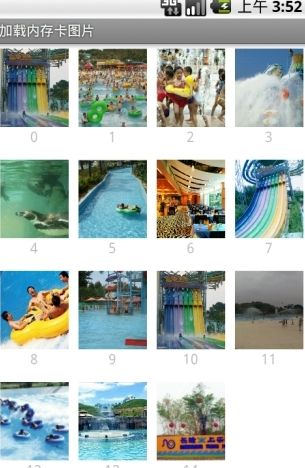Android GridView 异步加载图片
网上的资源普遍上是ListView异步加载图片,比较少有GirdView异步加载图片,参考了ListView异步加载图片的做法把GridView的异步加载图片功能做出来,方法和思想大同小异,本文章把GridView异步加载内存卡和网络图片希望对大家有用。效果图如下:
一、主界面代码:
import java.util.ArrayList;
import java.util.List;
import android.app.Activity;
import android.os.Bundle;
import android.widget.GridView;
public class MainActivity extends Activity {
/** Called when the activity is first created. */
@Override
public void onCreate(Bundle savedInstanceState) {
super.onCreate(savedInstanceState);
setContentView(R.layout.main);
GridView gridView=(GridView)findViewById(R.id.gridview);
List list = new ArrayList();
String[] paths=new String[15];
for(int i=0;i<15;i++){
int index=i;
paths[i]="/sdcard/"+String.valueOf(index+1)+".jpg";//自己动手向SD卡添加15张图片,如:1.jpg
}
for(int i=0;i<15;i++){
list.add(new ImageAndText(paths[i], String.valueOf(i)));
}
gridView.setAdapter(new ImageAndTextListAdapter(this, list, gridView));
}
} 二、以下代码是实现异步获取图片的主方法,SoftReference是软引用,是为了更好的为了系统回收变量,重复的URL直接返回已有的资源,实现回调函数,让数据成功后,更新到UI线程。
import java.io.IOException;
import java.io.InputStream;
import java.lang.ref.SoftReference;
import java.net.MalformedURLException;
import java.net.URL;
import java.util.HashMap;
import android.R.drawable;
import android.graphics.Bitmap;
import android.graphics.BitmapFactory;
import android.graphics.BitmapFactory.Options;
import android.graphics.drawable.BitmapDrawable;
import android.graphics.drawable.Drawable;
import android.os.Handler;
import android.os.Message;
import android.util.Log;
import android.widget.ImageView;
public class AsyncImageLoader {
private HashMap> imageCache;
public AsyncImageLoader() {
imageCache = new HashMap>();
}
public Drawable loadDrawable(final String imageUrl, final ImageCallback imageCallback) {
if (imageCache.containsKey(imageUrl)) {
SoftReference softReference = imageCache.get(imageUrl);
Drawable drawable = softReference.get();
if (drawable != null) {
return drawable;
}
}
final Handler handler = new Handler() {
public void handleMessage(Message message) {
imageCallback.imageLoaded((Drawable) message.obj, imageUrl);
}
};
new Thread() {
@Override
public void run() {
Drawable drawable = loadImageFromUrl(imageUrl);
imageCache.put(imageUrl, new SoftReference(drawable));
Message message = handler.obtainMessage(0, drawable);
handler.sendMessage(message);
}
}.start();
return null;
}
public static Drawable loadImageFromUrl(String url) {
// /**
// * 加载网络图片
// */
// URL m;
// InputStream i = null;
// try {
// m = new URL(url);
// i = (InputStream) m.getContent();
// } catch (MalformedURLException e1) {
// e1.printStackTrace();
// } catch (IOException e) {
// e.printStackTrace();
// }
// Drawable d = Drawable.createFromStream(i, "src");
/**
* 加载内存卡图片
*/
Options options=new Options();
options.inSampleSize=2;
Bitmap bitmap=BitmapFactory.decodeFile(url, options);
Drawable drawable=new BitmapDrawable(bitmap);
return drawable;
}
public interface ImageCallback {
public void imageLoaded(Drawable imageDrawable, String imageUrl);
}
} import java.util.List;
import cn.wangmeng.test.AsyncImageLoader.ImageCallback;
import android.app.Activity;
import android.graphics.drawable.Drawable;
import android.util.Log;
import android.view.LayoutInflater;
import android.view.View;
import android.view.ViewGroup;
import android.widget.ArrayAdapter;
import android.widget.GridView;
import android.widget.ImageView;
import android.widget.ListView;
import android.widget.TextView;
public class ImageAndTextListAdapter extends ArrayAdapter {
private GridView gridView;
private AsyncImageLoader asyncImageLoader;
public ImageAndTextListAdapter(Activity activity, List imageAndTexts, GridView gridView1) {
super(activity, 0, imageAndTexts);
this.gridView = gridView1;
asyncImageLoader = new AsyncImageLoader();
}
public View getView(int position, View convertView, ViewGroup parent) {
Activity activity = (Activity) getContext();
// Inflate the views from XML
View rowView = convertView;
ViewCache viewCache;
if (rowView == null) {
LayoutInflater inflater = activity.getLayoutInflater();
rowView = inflater.inflate(R.layout.griditem, null);
viewCache = new ViewCache(rowView);
rowView.setTag(viewCache);
} else {
viewCache = (ViewCache) rowView.getTag();
}
ImageAndText imageAndText = getItem(position);
// Load the image and set it on the ImageView
String imageUrl = imageAndText.getImageUrl();
ImageView imageView = viewCache.getImageView();
imageView.setTag(imageUrl);
Drawable cachedImage = asyncImageLoader.loadDrawable(imageUrl, new ImageCallback() {
public void imageLoaded(Drawable imageDrawable, String imageUrl) {
ImageView imageViewByTag = (ImageView) gridView.findViewWithTag(imageUrl);
if (imageViewByTag != null) {
imageViewByTag.setImageDrawable(imageDrawable);
}
}
});
if (cachedImage == null) {
imageView.setImageResource(R.drawable.icon);
}else{
imageView.setImageDrawable(cachedImage);
}
// Set the text on the TextView
TextView textView = viewCache.getTextView();
textView.setText(imageAndText.getText());
return rowView;
}
} 四、2个辅助类:
public class ImageAndText {
private String imageUrl;
private String text;
public ImageAndText(String imageUrl, String text) {
this.imageUrl = imageUrl;
this.text = text;
}
public String getImageUrl() {
return imageUrl;
}
public String getText() {
return text;
}
}public class ViewCache {
private View baseView;
private TextView textView;
private ImageView imageView;
public ViewCache(View baseView) {
this.baseView = baseView;
}
public TextView getTextView() {
if (textView == null) {
textView = (TextView) baseView.findViewById(R.id.text);
}
return textView;
}
public ImageView getImageView() {
if (imageView == null) {
imageView = (ImageView) baseView.findViewById(R.id.image);
}
return imageView;
}
}1griditem:
2main:
六、大功告成,总结方法。